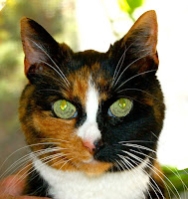Jessie, is a 13-year old female DSH cat that presented to our clinic for annual exam and vaccines. The owner reports that Jessie has been doing fairly well, but that the cat has been drinking more water over the last 4 months. The cat has also been progressively losing weight over the past year, dropping from 4.2 kg to 3.6 kg.
My physical examination was unremarkable, except for evidence of mild muscle wasting. Because of the signs of weight loss and polyuria, we ran a complete blood count and serum chemistry profile, but all of the results (including the serum creatinine, BUN, glucose, and calcium) were within reference range limits.
We also did a serum T4, which showed a high-normal value of 51 nmol/L (reference range, 13-51 nmol/L). Because of the high-normal serum total T4 concentration, I added on a free T4 by dialysis, which came back high at 81 pmol/L (reference range, 10-50 pmol/L).
Based on those thyroid results, I made a diagnosis of hyperthyroidism and started the cat on methimazole (Felimazole, Dechra) at a dosage of 2.5 mg, PO, once daily. After 2 weeks, we rechecked the kidney values (which remained normal) and a free T4 concentration (which was higher than the pretreatment value at 88 pmol/L).
So my main questions include the following:
Thanks. Any help would be much appreciated.
My Response:
My first question is: do you think that cat really is hyperthyroid? I know that the cat has lost weight, but you have examined the cat 2 to 3 times and I don't see any mention of a thyroid nodule. Is there tachycardia or any other clinical signs? Is there improvement in the clinical signs after methimazole?
Determination of free T4 concentrations can be helpful in diagnosis of cats with early or mild hyperthyroidism (1), but the test is pretty worthless in monitoring initial methimazole or I-131 treatment. In addition, falsely high free T4 values have been reported in up to 12% of cats with nonthyroidal illness (1,2).
It does bother me that this cat has lost so much weight and is showing signs of polyuria and polydipsia with these mild thyroid values. Could this cat have nonthyroidal illness and not be hyperthyroid at all?
What I do in borderline cats like this is to do one of the following, especially when a thyroid nodule canot be palpated (2-6):
Bottom Line: If you are not sure that the cat is hyperthyroid, treating with an antithyroid drug, at least in my opinion, is not a wise choice given that side effects (some serious) can occur. I understand that we all want to look at the "numbers." But when the thyroid numbers are wrong (as they can be), we can never forget that we first must look a the patient.
In other words, we don't treat abnormal lab values — we treat the cat.
My physical examination was unremarkable, except for evidence of mild muscle wasting. Because of the signs of weight loss and polyuria, we ran a complete blood count and serum chemistry profile, but all of the results (including the serum creatinine, BUN, glucose, and calcium) were within reference range limits.
We also did a serum T4, which showed a high-normal value of 51 nmol/L (reference range, 13-51 nmol/L). Because of the high-normal serum total T4 concentration, I added on a free T4 by dialysis, which came back high at 81 pmol/L (reference range, 10-50 pmol/L).
Based on those thyroid results, I made a diagnosis of hyperthyroidism and started the cat on methimazole (Felimazole, Dechra) at a dosage of 2.5 mg, PO, once daily. After 2 weeks, we rechecked the kidney values (which remained normal) and a free T4 concentration (which was higher than the pretreatment value at 88 pmol/L).
So my main questions include the following:
- Why is the free T4 by ED is still high?
- Should I only be assessing the free T4 along with a total T4 concentration? I know that this is important when first trying to diagnose hyperthyroidism, but was wondering if I should be measuring both total and free T4 values on rechecks as well.
- Could the timing of the blood collection make a difference considering she is on SID dosing? She reports that she gives the cat her medication at about midnight and her sample would have been collected at 5:20 PM (so about 17 hours post-pill).
Thanks. Any help would be much appreciated.
My Response:
My first question is: do you think that cat really is hyperthyroid? I know that the cat has lost weight, but you have examined the cat 2 to 3 times and I don't see any mention of a thyroid nodule. Is there tachycardia or any other clinical signs? Is there improvement in the clinical signs after methimazole?
Determination of free T4 concentrations can be helpful in diagnosis of cats with early or mild hyperthyroidism (1), but the test is pretty worthless in monitoring initial methimazole or I-131 treatment. In addition, falsely high free T4 values have been reported in up to 12% of cats with nonthyroidal illness (1,2).
It does bother me that this cat has lost so much weight and is showing signs of polyuria and polydipsia with these mild thyroid values. Could this cat have nonthyroidal illness and not be hyperthyroid at all?
What I do in borderline cats like this is to do one of the following, especially when a thyroid nodule canot be palpated (2-6):
- Repeat the serum total T4 in a week or two using a different technique (either RIA or Chemiluminescence - ie, Immulite methods). Many labs now use an automatic immunoassay technique, which can sometimes be misleading. But remember, the T4 will fluctuate over time, and some "normal" cats just have higher T4 values than the average normal cat. If you get a high total T4 value, we have the answer. Note that falsely high total T4 values do not occur unless there is lab error.
- Repeat the FT4 at the same time as the repeat TT4 test. You have already done this step in this cat, but you didn't repeat the T4 and the cat is on methimazole. Again, a high value with a normal TT4 and no thyroid nodule really doesn't tell you that the cat is hyperthyroid for sure!
- If this in not helpful (i.e., the total T4 not high), then I do either a T3 suppression test or thyroid scintigraphy.
- Finally, we can just wait and monitor. Over time — generally 3 months — the thyroid tumor (if present) will grow and the T4 will be clearly high. If there is nonthyroidal illness, this will usually become obvious with enough time.
Bottom Line: If you are not sure that the cat is hyperthyroid, treating with an antithyroid drug, at least in my opinion, is not a wise choice given that side effects (some serious) can occur. I understand that we all want to look at the "numbers." But when the thyroid numbers are wrong (as they can be), we can never forget that we first must look a the patient.
In other words, we don't treat abnormal lab values — we treat the cat.
References:
- Peterson ME, Melian C, Nichols R. Measurement of serum concentrations of free thyroxine, total thyroxine, and total triiodothyronine in cats with hyperthyroidism and cats with nonthyroidal disease. Journal of the American Veterinary Medical Association 2001;218:529-536.
- Mooney CT, Little CJ, Macrae AW. Effect of illness not associated with the thyroid gland on serum total and free thyroxine concentrations in cats. Journal of the American Veterinary Medical Association 1996;208:2004-2008.
- Baral R, Peterson ME. Thyroid gland disorders. In: Little, S.E. (ed), The Cat: Clinical Medicine and Management. Philadelphia, Elsevier Saunders 2012;571-592.
- Mooney CT, Peterson ME: Feline hyperthyroidism, In: Mooney C.T., Peterson M.E. (eds), Manual of Canine and Feline Endocrinology (Fourth Ed), Quedgeley, Gloucester, British Small Animal Veterinary Association, 2012; in press.
- Peterson ME: Hyperthyroidism in cats, In: Rand, J (ed), Clinical Endocrinology of Companion Animals. New York, Wiley-Blackwell, 2012; in press.
- Peterson ME. Diagnostic tests for hyperthyroidism in cats. Clinical Techniques in Small Animal Practice 2006;21:2-9.
- Peterson ME, Kintzer PP, Hurvitz AI. Methimazole treatment of 262 cats with hyperthyroidism. Journal of Veterinary Internal Medicine 1988;2:150–157.
- Trepanier LA, Hoffman SB, Knoll M, et al. Efficacy and safety of once versus twice daily administration of methimazole in cats with hyperthyroidism. Journal of the American Veterinary Medical Association 2003;222:954–958.
- Rutland BE, Nachreiner RF, Kruger JM. Optimal testing for thyroid hormone concentration after treatment with methimazole in healthy and hyperthyroid cats. Journal of Veterinary Internal Medicine 2009;23:1025-1030.
Źródło: endocrinevet.blogspot.com












